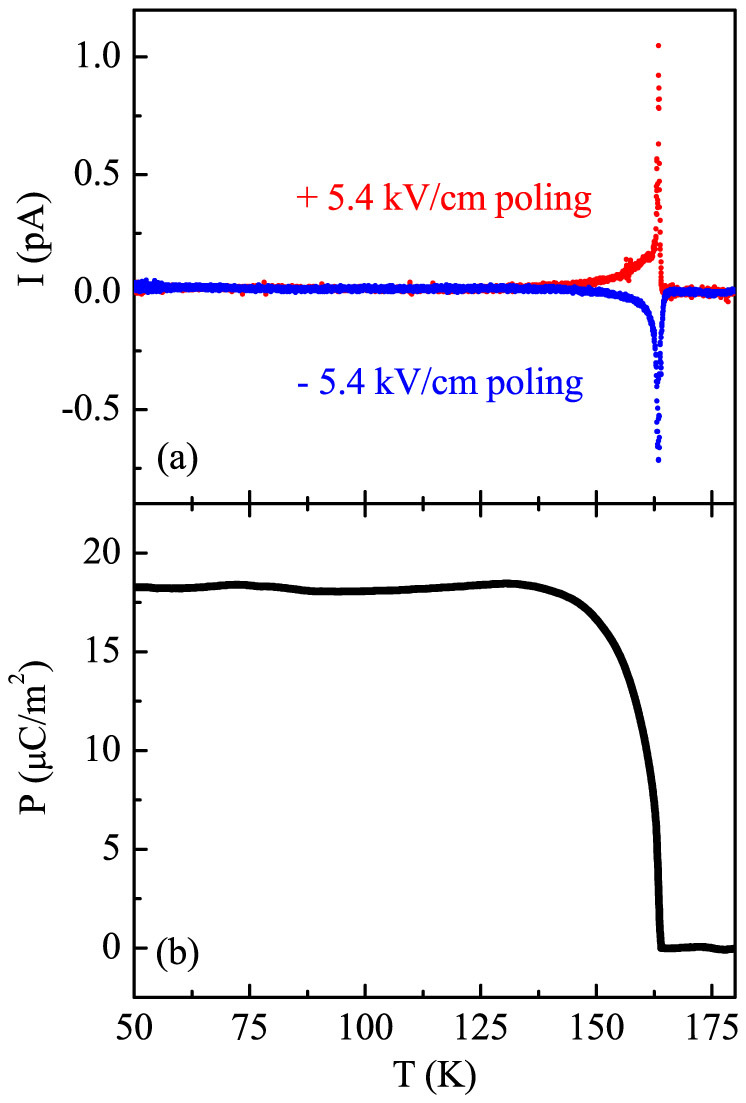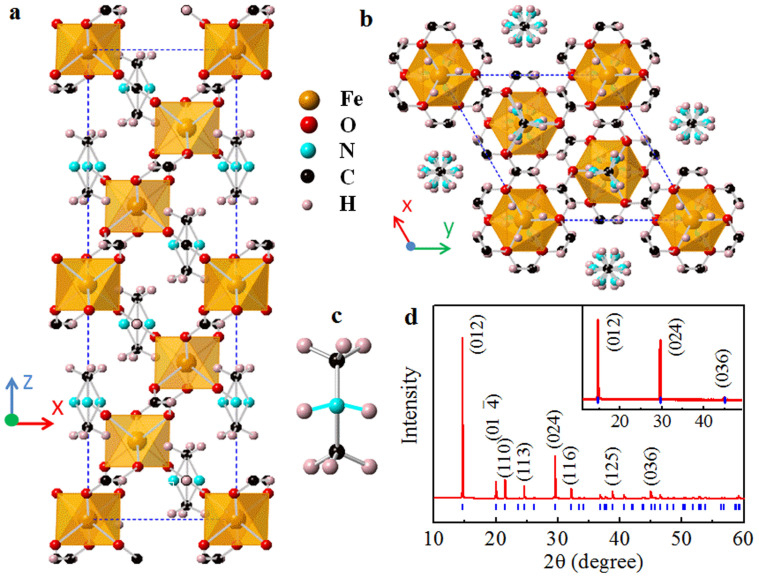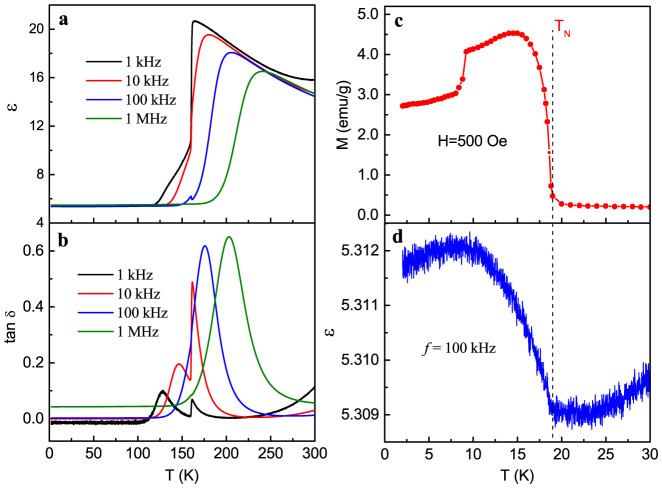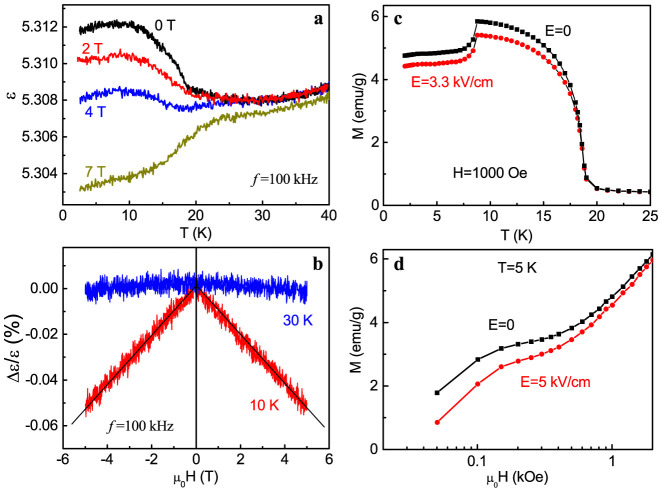Abstract
The coexistence of both electric and magnetic orders in some metal-organic frameworks (MOFs) has yielded a new class of multiferroics beyond inorganic materials. However, the coupling between two orders in multiferroic MOFs has not been convincingly verified yet. Here we present clear experimental evidences of cross coupling between electric and magnetic orders in a multiferroic MOF [(CH3)2NH2]Fe(HCOO)3 with a perovskite structure. The dielelectric constant exhibit a hump just at the magnetic ordering temperature TN. Moreover, both the direct (magnetic field control of dielectric properties) and converse (electric field control of magnetization) magnetoelectric effects have been observed in the multiferroic state. This work opens up new insights on the origin of ferroelectricity in MOFs and highlights their promise as magnetoelectric multiferroics.
The mutual control of dielectric/ferroelectric properties by magnetic fields and magnetism by electric fields, known as the magnetoelectric (ME) coupling effects, has a great potential for many applications1,2,3. Promising candidate materials allowing the ME effects are multiferroic material in which magnetic and electric orders coexist. While the past decade has seen an extensive search for multiferroic materials in inorganic compounds and composites4,5,6,7, organic multiferroics have been rarely found. Only recently, a few examples of coexisting electric and magnetic orders in hybrid organic-inorganic materials such as metal-organic frameworks (MOFs) have been reported8,9,10,11. MOFs are ordered crystalline structures composed of inorganic metal ions and organic linkers12,13,14. They are known to show diverse physical and chemical properties arising from the porous structure as well as the organic-inorganic duality15,16,17,18,19,20,21,22. In particular, the MOFs with the ABX3 perovskite-like structure are of great interest because the variable A and B components provide plenty of room for adjusting the magnetic and electric properties in a simple crystalline structure. In 2009, Jain et al. reported a multiferroic behavior in a family of perovskite MOFs8. This finding has stimulated considerable experimental and theoretical efforts to search for new multiferroic materials in MOFs9,10,11,23,24,25,26,27,28,29,30. However, the cross coupling between magnetic and electric orders in MOFs, an extremely important feature required for applications, has not been verified in previous studies, which has casted doubt on the promise of organic multiferroics.
In this work, we present strong experimental evidences of cross coupling between electric and magnetic orders in an iron-based multiferroic MOF [(CH3)2NH2]Fe(HCOO)3 (Fe-MOF). Both the direct and converse ME effects have been clearly demonstrated in the multiferroic state. These results open up new insights on the origin of muliferroics in perovskite MOFs.
Results
Structural characterization of the Fe-MOF
The multiferroic MOF reported here has a formula of [(CH3)2NH2]Fe(HCOO)3 with a ABX3 perovskite structure. The top and side views of the crystalline structure of the Fe-MOF are shown in Fig. 1a and 1b, respectively. The metal cations (B = Fe2+) linked by the formate groups (X = HCOO−) form the BX3 skeleton, and the dimethylammonium (DMA) cations (A = [(CH3)2NH2]+) occupy the cavities. The amine hydrogen atoms of DMA+ shown in Fig. 1c can form hydrogen bonds with the oxygen atoms of the formate groups. We have prepared single-crystal samples of the Fe-MOF by solvothermal condition method. Powder X-ray diffraction (XRD) pattern at room temperature shown in Fig. 1d confirmed the structure and phase purity of the synthesized samples. The single-crystal XRD pattern (the inset of Fig. 1d) suggests that the crystals are naturally grown layer by layer along [012] direction.
Figure 1. Structural characterization of [(CH3)2NH2]Fe(HCOO)3.
(a) Side and (b) top view of the crystalline structure. (c) The A-group cation (DMA+). (d) Powder x-ray diffraction patteren of prepared samples at room temperature. The inset shows the single crystal x-ray diffraction pattern.
Coexistence of electric and magnetic orders in the Fe-MOF
The dielectric constant and dielectric loss along [012] direction of the Fe-MOF as a function of temperature are shown in Fig. 2a and 2b, respectively. A dielectric phase transition, as evidenced by the pronounced peaks in the dielectric constant and loss tangent, is observed at TC ~ 164 K. The strong frequency dependence of the dielectric peaks indicate a relaxor nature of the electric ordering. In order to clarify the nature of this dielectric transition, we have performed the pyroelectric current measurements. As seen in Fig. 3a, a small pyroelectric peak is observed at the dielectric phase transition temperature. The obtained electric polarization along [012] (Fig. 3b) is ~18 μC/m2, suggesting a weak ferroelectricity below TC ~ 164 K.
Figure 2. Coexistence of electric and magnetic orders in the Fe-MOF.
(a) The dielectric constant and (b) the dielectric loss as a function of temperature. A dielectric phase transition is observed at TC ~ 164 K. (c) The magnetization as a function of temperature. A magnetic ordering is observed at TN ~ 19 K. (d) The dielectric constant rises up just at TN, indicating a magnetoelectric coupling.
Figure 3. Weak ferroelectricity in the Fe-MOF.

(a) The pyroelectric current as a function of temperature along [012]. The sharp pyroelectric peak signals a ferroelectric transition. (b) The electric polarization along [012] obtained by integrating the pyroelectric current with time as a function of temperature. The value is an average of positive and negative poling.
In addition to ferroelectric ordering, this perovskite Fe-MOF also exhibits magnetic orders at low temperature. Fig. 2c shows the magnetization along [012] as a function of temperature measured after a zero-magnetic-field cooling (ZFC) process. Two magnetic transitions can be identified: one at TN ~ 19 K and another around TB ~ 10 K. A careful study has suggested that there is a magnetic phase separation in this perovskite Fe-MOF21. Accordingly, the sharp transition at TN is due to the onset of a spin canted antiferromagnetic ordering, and the drop of the ZFC magnetization below TB is due to the blocking of single-ion quantum magnets. As seen in Fig. 2d, just at the magnetic ordering temperature TN, the dielectric constant rises up. This coincidence between magnetic ordering and dielectric anomaly, as observed in many inorganic magnetoelectric multiferroics, has been generally considered as a strong evidence for ME coupling31,32.
The magnetoelectric effects in the multiferroic state
To further testify the coupling between electric and magnetic orders in the Fe-MOF, we studied the magnetic field dependence of the dielectric constant along [012]. As shown in Fig. 4a and 4b, the dielectric constant is apparently suppressed by external magnetic fields in the multiferroic state below TN. At 10 K, it decreases linearly with increasing magnetic field. In contrast, at 30 K (i.e., above TN), the influence of magnetic field is almost negligible. These results prove that the ME effect happens mainly in the magnetically-ordered (multiferroic) state.
Figure 4. The magnetoelectric effects in the multiferroic state.
(a) The dielectric constant as a function of temperature measured in different magnetic fields. (b) The magnetodielectric ratio as a function of magnetic field at 10 and 30 K.(c) The magnetization as a function of temperature with and without electric-field poling. (d) The M-H curves at 5 K with and without electric-field poling.
After demonstrating the direct ME effect, we then explored the converse ME effect (electric field control of magnetism) in the Fe-MOF. Firstly, we compared the M-T curves with and without electric-field poling. In these measurements, the sample was cooled from 300 to 2 K in zero magnetic field, and the magnetization was recorded with warming. The electric-field poling was performed as follows: an electric field was applied along [012] at 200 K during the cooling process and removed at 2 K. As shown in Fig. 4c, the magnetization in the multiferroic state is apparently altered by electric-field poling, evidencing the converse ME effect. Secondly, we compared the M-H isotherms at 5 K with and without electric-field poling. As shown in Fig. 4d, the difference between two isotherms is pronounced, especially in low magnetic fields. These results confirm that the electric field control of magnetization can be realized in this multiferroic Fe-MOF.
Discussion
Our experimental results provide clear evidences for the cross coupling between electric and magnetic orders in the perovskite Fe-MOF. These findings suggest us to reconsider the mechanism of multiferroics in perovskite MOFs. In early viewpoints, the magnetic and electric ordering in multiferroic MOFs were considered to originate separately: the former is simply due to the superexchange interaction through the B-X-B path, and the latter is solely due to the order-disorder transition of the organic A-groups8,9,10,33,34,35. As the magnetic and ferroelectric ordering develops independently at different sites, a cross coupling between them would not be expected. However, our experimental findings do not support these arguments. In fact, some of us performed theoretical simulations on several MOFs and showed that non-polar distortions in the BX3 framework can induce polar distortions on the A-group molecules, compatible with a ferroelectric behavior23,27,28. These results suggest that the ferroelectric/antiferroelectric ordering in perovskite MOFs could have a “hybrid” nature involving both the A-group organic cations and the B-site metal ions. This hybrid nature is more prominent when the metal ion is a Jahn-Teller ion and the A-group molecule is a non-polar cation23,27,28. In this case, the magnetic and electric orders are coupled and the ME effects would be expected. Due to the lack of detailed information on the crystal structure at low temperature in the multiferroic state, a quantitative calculation of the ME coupling in the present Fe-MOF are not yet available, but it is reasonable to expect that a ME coupling would have a similar “hybrid” nature in this case, i.e., arising from distortions in the BX3 framework and dipolar effects on the A-group, coupled by hydrogen bond networks. It is important to note that, however, both direct and converse ME effects experimentally shown in the Fe-MOF are qualitatively consistent with previous theoretical predictions23,27,28.
In conclusion, we have observed both direct and converse ME effects in the multiferroic state of a perovskite Fe-MOF. These findings verify our theoretical predictions that ferroelectricity in some perovskite MOFs has a “hybrid” nature involving both the A-group organic cations and the B-site magnetic ions. Thus, a cross coupling between electric and magnetic orders becomes possible in multiferroic MOFs. Our work highlights the promise of the perovskite MOFs as a new type of magnetoelectric multiferroics beyond inorganic materials.
Methods
Sample preparation and x-ray diffraction
Hydrothermal method have been used to grow single crystals of [(CH3)2NH2]Fe(HCOO)3. Firstly the solution containing 5 mmol FeCl2·4H2O, equal volume of deionized water and dimethylformamide (DMF) of 65 ml, is put in a 100 ml polytetrafluoroethylene-lined hydrothermal synthesis reactor, heating for 3 days at 140°C. Then the supernatant is removed to a round-bottom flask for crystallization by the method of slow evaporation at room temperature for 5 days. At last, we remove the crystals from the mother liquid, wash them with ethanol for 3 times, and then store them in Ar protective atmosphere. Powder and single-crystal X-ray diffraction measurements were performed at room temperature using a X-ray diffractometer (Rigaku 2000) with Cu Kα1 radiation (λ = 1.5406 Å).
Magnetic and electric measurements
Magnetic properties were measured with a superconducting quantum interference device magnetometer (Quantum Design MPMS). Electric field was applied on the sample by introducing two Cu wires in a standard sample probe. Dielectric constant was measured with a Agilent 4980 LCR meter in a Cryogen-free Superconducting Magnet System (Oxford Instruments, TeslatronPT) with a home-made probe. For the pyroelectric measurements, the sample was poled in a positive or negative electric field of 5.4 kV/cm from 180 to 2 K. After removing the poling electric field and releasing space charges for at least 30 minutes, the pyroelectric current was recorded with warming at a constant rate of 2 k/min. All the magnetic and electric measurements were performed along the [012] direction of single-crystal samples.
Acknowledgments
This work was supported by the National Key Basic Research Program of China under Grant No. 2011CB921801, the Natural Science Foundation of China under Grants Nos. 11227405, 51371193, and the Strategic Priority Research Program of the Chinese Academy of Sciences under Grant No. XDB07030200.
Footnotes
The authors declare no competing financial interests.
Author Contributions Y.S. and A.S. conceived the project. Y.T. and L.Y. prepared the samples. Y.T., Y.C. and S.W. performed the x-ray diffraction, magnetic, and electric measurements. A.S., P.B. and S.P. contributed theoretical analysis. Y.S., Y.T., A.S. and S.P. wrote the paper and all of the authors commented on the paper.
References
- Fiebig M. Revival of the magnetoelectric effect. J. Phys. D-Appl. Phys. 38, R123–R152 (2005). [Google Scholar]
- Eerenstein W., Mathur N. D. & Scott J. F. Multiferroic and magnetoelectric materials. Nature 442, 759–765 (2006). [DOI] [PubMed] [Google Scholar]
- Wang K. F., Liu J. M. & Ren Z. F. Multiferroicity: the coupling between magnetic and polarization orders. Adv. Phys. 58, 321–448 (2009). [Google Scholar]
- Cheong S. W. & Mostovoy M. Multiferroics: a magnetic twist for ferroelectricity. Nat. Mater 6, 13–20 (2007). [DOI] [PubMed] [Google Scholar]
- Spaldin N. A., Cheong S. W. & Ramesh R. Multiferroics: past, present, and future. Phys. Today 63, 38–43 (2010). [Google Scholar]
- Sun Y., Yan L. Q. & Cong J. Z. Multiferroics and magnetoelectric effects in charge ordered compounds. Sci. China-Phys. Mech. Astron. 56, 222–231 (2013). [Google Scholar]
- Nan C. W., Bichurin M. I., Dong S. X., Viehland D. & Srinivasan G. Multiferroic magnetoelectric composites: historical perspective, status, and future directions. J. Appl. Phys. 103, 35 (2008). [Google Scholar]
- Jain P. et al. Multiferroic behavior associated with an order-disorder hydrogen bonding transition in metal-organic frameworks (MOFs) with the perovskite ABX3 architecture. J. Am. Chem. Soc. 131, 13625–13627 (2009). [DOI] [PubMed] [Google Scholar]
- Rogez G., Viart N. & Drillon M. Multiferroic materials: the attractive approach of metal-organic frameworks (MOFs). Angew. Chem. Int. Ed. Engl. 49, 1921–1923 (2010). [DOI] [PubMed] [Google Scholar]
- Xu G. C. et al. Coexistence of magnetic and electric orderings in the metal-formate frameworks of [NH4][M(HCOO)3]. J. Am. Chem. Soc. 133, 14948–14951 (2011). [DOI] [PubMed] [Google Scholar]
- Canadillas-Delgado L. et al. The role of order-disorder transitions in the quest for molecular multiferroics: structural and magnetic neutron studies of a mixed valence iron(ii)-iron(iii) formate framework. J. Am. Chem. Soc. 134, 19772–19781 (2012). [DOI] [PubMed] [Google Scholar]
- Yaghi O. M., Li G. M. & Li H. L. Selective binding and removal of guests in a microporous metal-organic framework. Nature 378, 703–706 (1995). [Google Scholar]
- Kitagawa S., Kitaura R. & Noro S. Functional porous coordination polymers. Angew. Chem. Int. Ed. 43, 2334–2375 (2004). [DOI] [PubMed] [Google Scholar]
- Cheetham A. K. & Rao C. N. R. There's room in the middle. Science 318, 58–59 (2007). [DOI] [PubMed] [Google Scholar]
- Jain P., Dalal N. S., Toby B. H., Kroto H. W. & Cheetham A. K. Order-disorder antiferroelectric phase transition in a hybrid inorganic-organic framework with the perovskite architecture. J. Am. Chem. Soc. 130, 10450–10451 (2008). [DOI] [PubMed] [Google Scholar]
- Weng D. F., Wang Z. M. & Gao S. Framework-structured weak ferromagnets. Chem. Soc. Rev. 40, 3157–3181 (2011). [DOI] [PubMed] [Google Scholar]
- Meek S. T., Greathouse J. A. & Allendorf M. D. Metal-organic frameworks: a rapidly growing class of versatile nanoporous materials. Adv. Mater. 23, 249–267 (2011). [DOI] [PubMed] [Google Scholar]
- Zhang W. & Xiong R.-G. Ferroelectric metal–organic frameworks. Chem. Rev. 112, 1163–1195 (2012). [DOI] [PubMed] [Google Scholar]
- Lorusso G. et al. A dense metal-organic framework for enhanced magnetic refrigeration. Adv. Mater. 25, 4653–4656 (2013). [DOI] [PubMed] [Google Scholar]
- Canepa P., Nijem N., Chabal Y. J. & Thonhauser T. Diffusion of small molecules in metal organic framework materials. Phys. Rev. Lett. 110, 5 (2013). [DOI] [PubMed] [Google Scholar]
- Tian Y. et al. Quantum tunneling of magnetization in a metal-organic framework. Phys. Rev. Lett. 112, 017202 (2014). [DOI] [PubMed] [Google Scholar]
- Zuluaga S., Canepa P., Tan K., Chabal Y. J. & Thonhauser T. Study of vander waals bonding and interactions in metal organic framework materials. J. Phys.: Condes. Matter 26, 15 (2014). [DOI] [PubMed] [Google Scholar]
- Stroppa A. et al. Electric control of magnetization and interplay between orbital ordering and ferroelectricity in a multiferroic metal-organic framework. Angew. Chem. Int. Ed. 50, 5847–5850 (2011). [DOI] [PubMed] [Google Scholar]
- Fu D. W. et al. A multiferroic perdeutero metal-organic framework. Angew. Chem. Int. Ed. 50, 11947–11951 (2011). [DOI] [PubMed] [Google Scholar]
- Pardo E. et al. Multiferroics by rational design: implementing ferroelectricity in molecule-based magnets. Angew. Chem. Int. Ed. 51, 8356–8360 (2012). [DOI] [PubMed] [Google Scholar]
- Zhang B., Zhang Y. & Zhu D. B. [(C2H5)3NH]2Cu2(C2O4)3: a three-dimensional metal-oxalato framework showing structurally related dielectric and magnetic transitions at around 165 k. Dalton Trans. 41, 8509–8511 (2012). [DOI] [PubMed] [Google Scholar]
- Stroppa A., Barone P., Jain P., Perez-Mato J. M. & Picozzi S. Hybrid improper ferroelectricity in a multiferroic and magnetoelectric metal-organic framework. Adv. Mater. 25, 2284–2290 (2013). [DOI] [PubMed] [Google Scholar]
- Di Sante D., Stroppa A., Jain P. & Picozzi S. Tuning the ferroelectric polarization in a multiferroic metal-organic framework. J. Am. Chem. Soc. 135, 18126–18130 (2013). [DOI] [PubMed] [Google Scholar]
- Wang W. et al. Magnetoelectric coupling in the paramagnetic state of a metal-organic framework. Sci. Rep. 3, 5 (2013). [DOI] [PMC free article] [PubMed] [Google Scholar]
- Pato-Doldan B. et al. Coexistence of magnetic and electrical order in the new perovskite-like (C3N2H5)[Mn(HCOO)3] formate. RSC Adv. 3, 22404–22411 (2013). [Google Scholar]
- Kimura T. et al. Magnetic control of ferroelectric polarization. Nature 426, 55–58 (2003). [DOI] [PubMed] [Google Scholar]
- Hur N. et al. Electric polarization reversal and memory in a multiferroic material induced by magnetic fields. Nature 429, 392–395 (2004). [DOI] [PubMed] [Google Scholar]
- Besara T. et al. Mechanism of the order-disorder phase transition, and glassy behavior in the metal-organic framework [(CH3)2NH2]Zn(HCOO)3. Proc. Natl. Acad. Sci. U. S. A. 108, 6828–6832 (2011). [Google Scholar]
- Thomson R. I., Jain P., Cheetham A. K. & Carpenter M. A. Elastic relaxation behavior, magnetoelastic coupling, and order-disorder processes in multiferroic metal-organic frameworks. Phys. Rev. B 86, 214304 (2012). [Google Scholar]
- Kundys B. et al. Multiferroicity and hydrogen-bond ordering in (C2H5NH3)2CuCl4 featuring dominant ferromagnetic interactions. Phys. Rev. B 81, 224434 (2010). [Google Scholar]





